Business and Corporate Law Report
VerifiedAdded on 2020/01/28
|6
|1553
|96
Report
AI Summary
This report analyzes the differences between partnerships and joint ventures in the context of business law. It discusses key features, applicable legal frameworks, and the advantages and disadvantages of each business structure. The conclusion recommends a limited liability partnership for a herbal product business, highlighting the benefits of limited liability while maintaining a partnership format.

BUSINESS AND
CORPORATE LAW
CORPORATE LAW
Paraphrase This Document
Need a fresh take? Get an instant paraphrase of this document with our AI Paraphraser
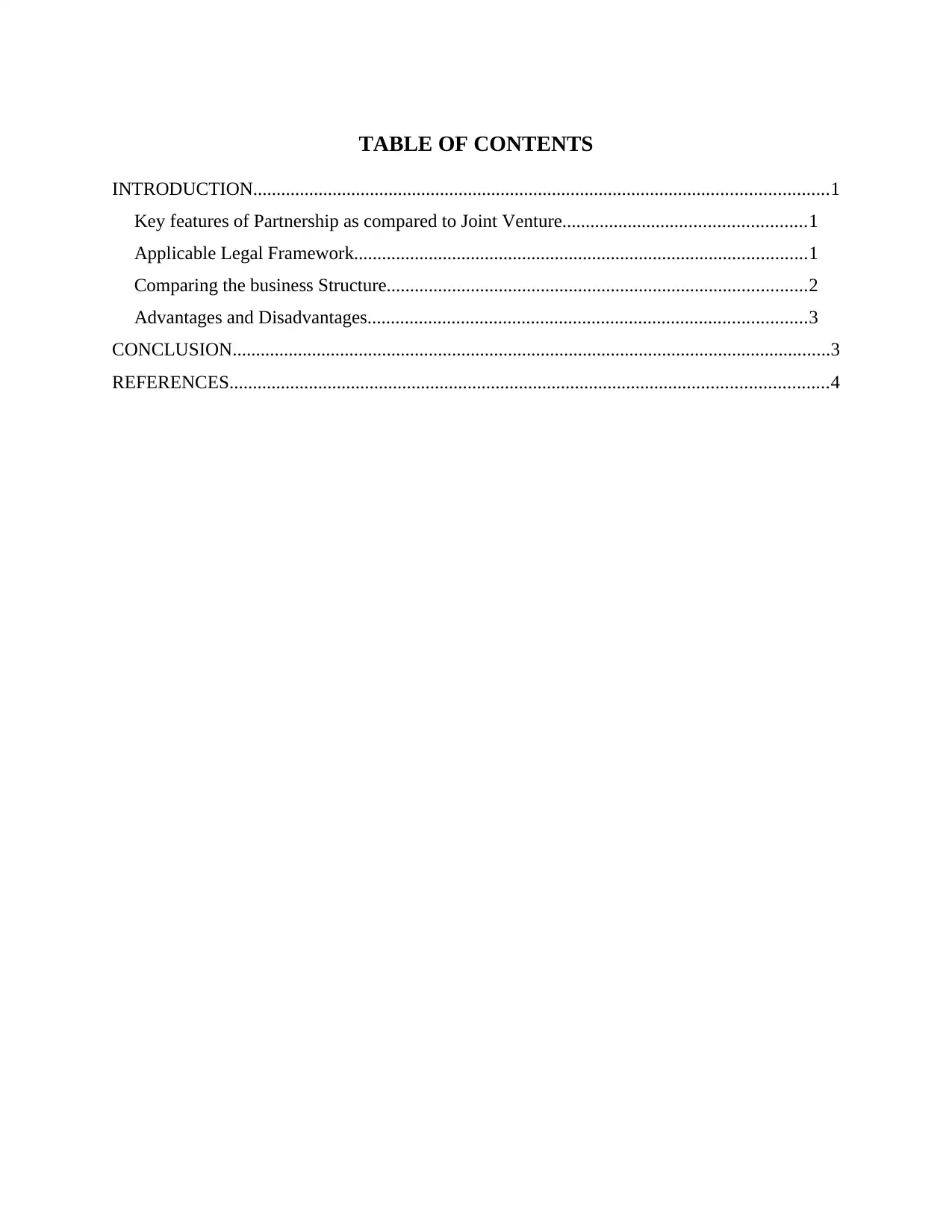
TABLE OF CONTENTS
INTRODUCTION...........................................................................................................................1
Key features of Partnership as compared to Joint Venture....................................................1
Applicable Legal Framework.................................................................................................1
Comparing the business Structure..........................................................................................2
Advantages and Disadvantages..............................................................................................3
CONCLUSION................................................................................................................................3
REFERENCES................................................................................................................................4
INTRODUCTION...........................................................................................................................1
Key features of Partnership as compared to Joint Venture....................................................1
Applicable Legal Framework.................................................................................................1
Comparing the business Structure..........................................................................................2
Advantages and Disadvantages..............................................................................................3
CONCLUSION................................................................................................................................3
REFERENCES................................................................................................................................4
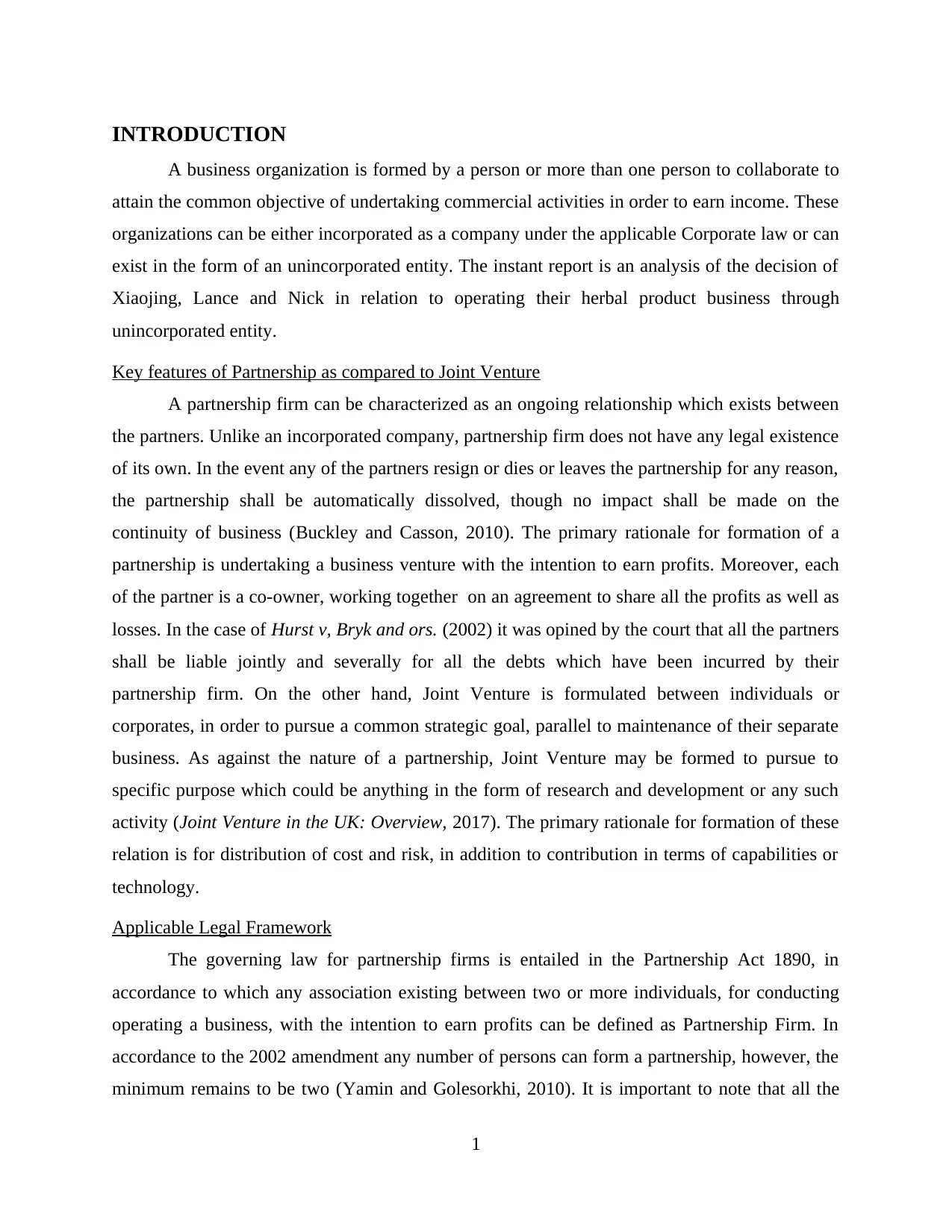
INTRODUCTION
A business organization is formed by a person or more than one person to collaborate to
attain the common objective of undertaking commercial activities in order to earn income. These
organizations can be either incorporated as a company under the applicable Corporate law or can
exist in the form of an unincorporated entity. The instant report is an analysis of the decision of
Xiaojing, Lance and Nick in relation to operating their herbal product business through
unincorporated entity.
Key features of Partnership as compared to Joint Venture
A partnership firm can be characterized as an ongoing relationship which exists between
the partners. Unlike an incorporated company, partnership firm does not have any legal existence
of its own. In the event any of the partners resign or dies or leaves the partnership for any reason,
the partnership shall be automatically dissolved, though no impact shall be made on the
continuity of business (Buckley and Casson, 2010). The primary rationale for formation of a
partnership is undertaking a business venture with the intention to earn profits. Moreover, each
of the partner is a co-owner, working together on an agreement to share all the profits as well as
losses. In the case of Hurst v, Bryk and ors. (2002) it was opined by the court that all the partners
shall be liable jointly and severally for all the debts which have been incurred by their
partnership firm. On the other hand, Joint Venture is formulated between individuals or
corporates, in order to pursue a common strategic goal, parallel to maintenance of their separate
business. As against the nature of a partnership, Joint Venture may be formed to pursue to
specific purpose which could be anything in the form of research and development or any such
activity (Joint Venture in the UK: Overview, 2017). The primary rationale for formation of these
relation is for distribution of cost and risk, in addition to contribution in terms of capabilities or
technology.
Applicable Legal Framework
The governing law for partnership firms is entailed in the Partnership Act 1890, in
accordance to which any association existing between two or more individuals, for conducting
operating a business, with the intention to earn profits can be defined as Partnership Firm. In
accordance to the 2002 amendment any number of persons can form a partnership, however, the
minimum remains to be two (Yamin and Golesorkhi, 2010). It is important to note that all the
1
A business organization is formed by a person or more than one person to collaborate to
attain the common objective of undertaking commercial activities in order to earn income. These
organizations can be either incorporated as a company under the applicable Corporate law or can
exist in the form of an unincorporated entity. The instant report is an analysis of the decision of
Xiaojing, Lance and Nick in relation to operating their herbal product business through
unincorporated entity.
Key features of Partnership as compared to Joint Venture
A partnership firm can be characterized as an ongoing relationship which exists between
the partners. Unlike an incorporated company, partnership firm does not have any legal existence
of its own. In the event any of the partners resign or dies or leaves the partnership for any reason,
the partnership shall be automatically dissolved, though no impact shall be made on the
continuity of business (Buckley and Casson, 2010). The primary rationale for formation of a
partnership is undertaking a business venture with the intention to earn profits. Moreover, each
of the partner is a co-owner, working together on an agreement to share all the profits as well as
losses. In the case of Hurst v, Bryk and ors. (2002) it was opined by the court that all the partners
shall be liable jointly and severally for all the debts which have been incurred by their
partnership firm. On the other hand, Joint Venture is formulated between individuals or
corporates, in order to pursue a common strategic goal, parallel to maintenance of their separate
business. As against the nature of a partnership, Joint Venture may be formed to pursue to
specific purpose which could be anything in the form of research and development or any such
activity (Joint Venture in the UK: Overview, 2017). The primary rationale for formation of these
relation is for distribution of cost and risk, in addition to contribution in terms of capabilities or
technology.
Applicable Legal Framework
The governing law for partnership firms is entailed in the Partnership Act 1890, in
accordance to which any association existing between two or more individuals, for conducting
operating a business, with the intention to earn profits can be defined as Partnership Firm. In
accordance to the 2002 amendment any number of persons can form a partnership, however, the
minimum remains to be two (Yamin and Golesorkhi, 2010). It is important to note that all the
1
⊘ This is a preview!⊘
Do you want full access?
Subscribe today to unlock all pages.

Trusted by 1+ million students worldwide
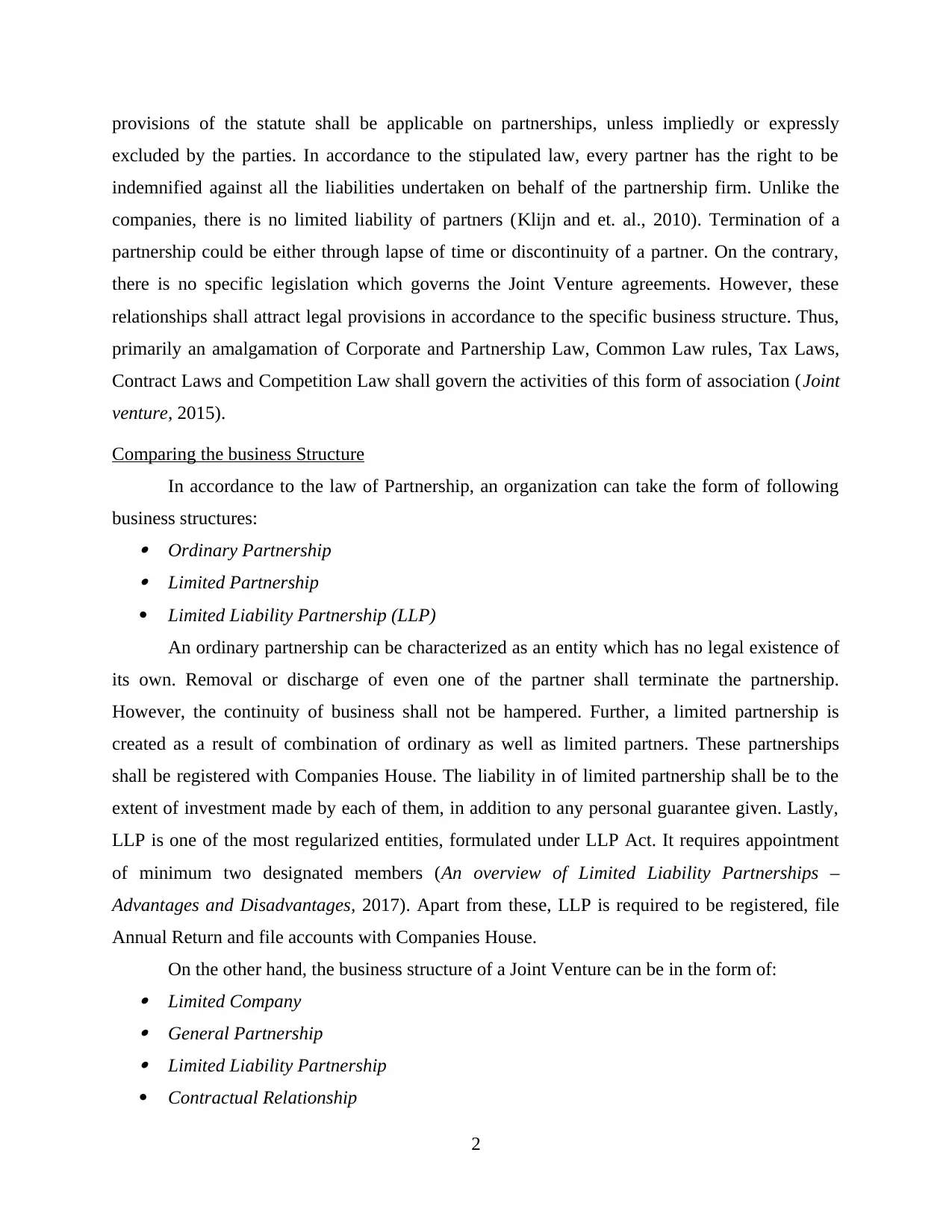
provisions of the statute shall be applicable on partnerships, unless impliedly or expressly
excluded by the parties. In accordance to the stipulated law, every partner has the right to be
indemnified against all the liabilities undertaken on behalf of the partnership firm. Unlike the
companies, there is no limited liability of partners (Klijn and et. al., 2010). Termination of a
partnership could be either through lapse of time or discontinuity of a partner. On the contrary,
there is no specific legislation which governs the Joint Venture agreements. However, these
relationships shall attract legal provisions in accordance to the specific business structure. Thus,
primarily an amalgamation of Corporate and Partnership Law, Common Law rules, Tax Laws,
Contract Laws and Competition Law shall govern the activities of this form of association (Joint
venture, 2015).
Comparing the business Structure
In accordance to the law of Partnership, an organization can take the form of following
business structures: Ordinary Partnership Limited Partnership
Limited Liability Partnership (LLP)
An ordinary partnership can be characterized as an entity which has no legal existence of
its own. Removal or discharge of even one of the partner shall terminate the partnership.
However, the continuity of business shall not be hampered. Further, a limited partnership is
created as a result of combination of ordinary as well as limited partners. These partnerships
shall be registered with Companies House. The liability in of limited partnership shall be to the
extent of investment made by each of them, in addition to any personal guarantee given. Lastly,
LLP is one of the most regularized entities, formulated under LLP Act. It requires appointment
of minimum two designated members (An overview of Limited Liability Partnerships –
Advantages and Disadvantages, 2017). Apart from these, LLP is required to be registered, file
Annual Return and file accounts with Companies House.
On the other hand, the business structure of a Joint Venture can be in the form of: Limited Company General Partnership Limited Liability Partnership
Contractual Relationship
2
excluded by the parties. In accordance to the stipulated law, every partner has the right to be
indemnified against all the liabilities undertaken on behalf of the partnership firm. Unlike the
companies, there is no limited liability of partners (Klijn and et. al., 2010). Termination of a
partnership could be either through lapse of time or discontinuity of a partner. On the contrary,
there is no specific legislation which governs the Joint Venture agreements. However, these
relationships shall attract legal provisions in accordance to the specific business structure. Thus,
primarily an amalgamation of Corporate and Partnership Law, Common Law rules, Tax Laws,
Contract Laws and Competition Law shall govern the activities of this form of association (Joint
venture, 2015).
Comparing the business Structure
In accordance to the law of Partnership, an organization can take the form of following
business structures: Ordinary Partnership Limited Partnership
Limited Liability Partnership (LLP)
An ordinary partnership can be characterized as an entity which has no legal existence of
its own. Removal or discharge of even one of the partner shall terminate the partnership.
However, the continuity of business shall not be hampered. Further, a limited partnership is
created as a result of combination of ordinary as well as limited partners. These partnerships
shall be registered with Companies House. The liability in of limited partnership shall be to the
extent of investment made by each of them, in addition to any personal guarantee given. Lastly,
LLP is one of the most regularized entities, formulated under LLP Act. It requires appointment
of minimum two designated members (An overview of Limited Liability Partnerships –
Advantages and Disadvantages, 2017). Apart from these, LLP is required to be registered, file
Annual Return and file accounts with Companies House.
On the other hand, the business structure of a Joint Venture can be in the form of: Limited Company General Partnership Limited Liability Partnership
Contractual Relationship
2
Paraphrase This Document
Need a fresh take? Get an instant paraphrase of this document with our AI Paraphraser
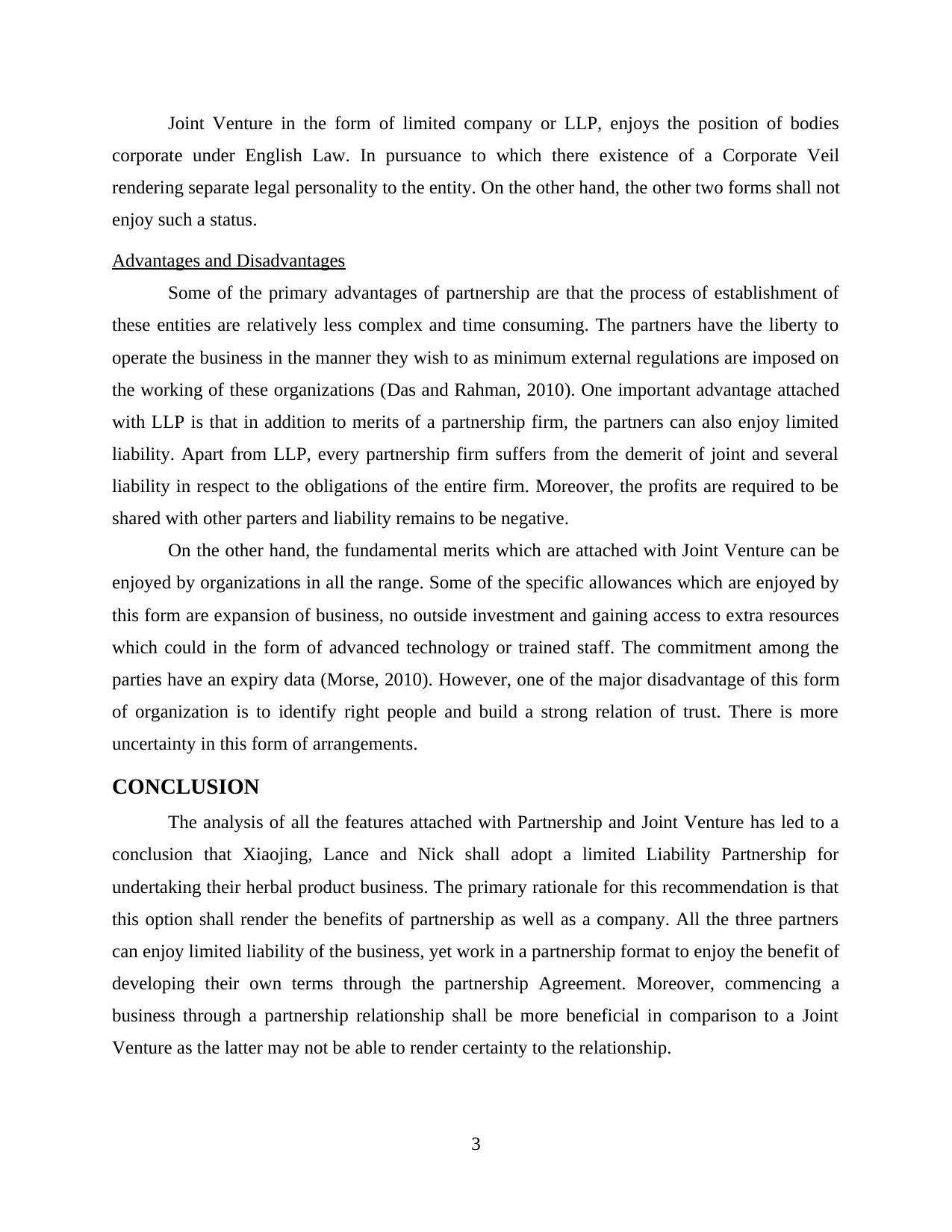
Joint Venture in the form of limited company or LLP, enjoys the position of bodies
corporate under English Law. In pursuance to which there existence of a Corporate Veil
rendering separate legal personality to the entity. On the other hand, the other two forms shall not
enjoy such a status.
Advantages and Disadvantages
Some of the primary advantages of partnership are that the process of establishment of
these entities are relatively less complex and time consuming. The partners have the liberty to
operate the business in the manner they wish to as minimum external regulations are imposed on
the working of these organizations (Das and Rahman, 2010). One important advantage attached
with LLP is that in addition to merits of a partnership firm, the partners can also enjoy limited
liability. Apart from LLP, every partnership firm suffers from the demerit of joint and several
liability in respect to the obligations of the entire firm. Moreover, the profits are required to be
shared with other parters and liability remains to be negative.
On the other hand, the fundamental merits which are attached with Joint Venture can be
enjoyed by organizations in all the range. Some of the specific allowances which are enjoyed by
this form are expansion of business, no outside investment and gaining access to extra resources
which could in the form of advanced technology or trained staff. The commitment among the
parties have an expiry data (Morse, 2010). However, one of the major disadvantage of this form
of organization is to identify right people and build a strong relation of trust. There is more
uncertainty in this form of arrangements.
CONCLUSION
The analysis of all the features attached with Partnership and Joint Venture has led to a
conclusion that Xiaojing, Lance and Nick shall adopt a limited Liability Partnership for
undertaking their herbal product business. The primary rationale for this recommendation is that
this option shall render the benefits of partnership as well as a company. All the three partners
can enjoy limited liability of the business, yet work in a partnership format to enjoy the benefit of
developing their own terms through the partnership Agreement. Moreover, commencing a
business through a partnership relationship shall be more beneficial in comparison to a Joint
Venture as the latter may not be able to render certainty to the relationship.
3
corporate under English Law. In pursuance to which there existence of a Corporate Veil
rendering separate legal personality to the entity. On the other hand, the other two forms shall not
enjoy such a status.
Advantages and Disadvantages
Some of the primary advantages of partnership are that the process of establishment of
these entities are relatively less complex and time consuming. The partners have the liberty to
operate the business in the manner they wish to as minimum external regulations are imposed on
the working of these organizations (Das and Rahman, 2010). One important advantage attached
with LLP is that in addition to merits of a partnership firm, the partners can also enjoy limited
liability. Apart from LLP, every partnership firm suffers from the demerit of joint and several
liability in respect to the obligations of the entire firm. Moreover, the profits are required to be
shared with other parters and liability remains to be negative.
On the other hand, the fundamental merits which are attached with Joint Venture can be
enjoyed by organizations in all the range. Some of the specific allowances which are enjoyed by
this form are expansion of business, no outside investment and gaining access to extra resources
which could in the form of advanced technology or trained staff. The commitment among the
parties have an expiry data (Morse, 2010). However, one of the major disadvantage of this form
of organization is to identify right people and build a strong relation of trust. There is more
uncertainty in this form of arrangements.
CONCLUSION
The analysis of all the features attached with Partnership and Joint Venture has led to a
conclusion that Xiaojing, Lance and Nick shall adopt a limited Liability Partnership for
undertaking their herbal product business. The primary rationale for this recommendation is that
this option shall render the benefits of partnership as well as a company. All the three partners
can enjoy limited liability of the business, yet work in a partnership format to enjoy the benefit of
developing their own terms through the partnership Agreement. Moreover, commencing a
business through a partnership relationship shall be more beneficial in comparison to a Joint
Venture as the latter may not be able to render certainty to the relationship.
3
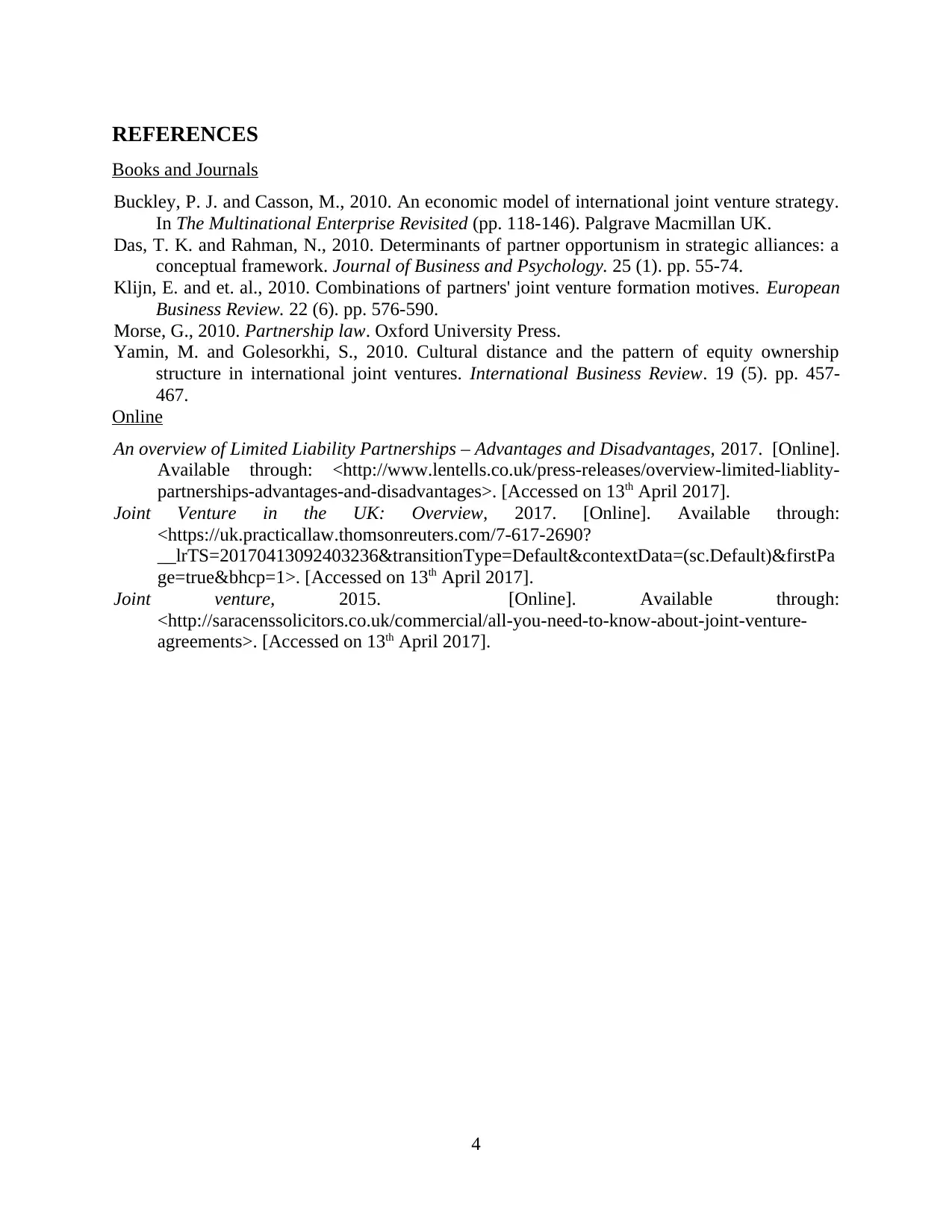
REFERENCES
Books and Journals
Buckley, P. J. and Casson, M., 2010. An economic model of international joint venture strategy.
In The Multinational Enterprise Revisited (pp. 118-146). Palgrave Macmillan UK.
Das, T. K. and Rahman, N., 2010. Determinants of partner opportunism in strategic alliances: a
conceptual framework. Journal of Business and Psychology. 25 (1). pp. 55-74.
Klijn, E. and et. al., 2010. Combinations of partners' joint venture formation motives. European
Business Review. 22 (6). pp. 576-590.
Morse, G., 2010. Partnership law. Oxford University Press.
Yamin, M. and Golesorkhi, S., 2010. Cultural distance and the pattern of equity ownership
structure in international joint ventures. International Business Review. 19 (5). pp. 457-
467.
Online
An overview of Limited Liability Partnerships – Advantages and Disadvantages, 2017. [Online].
Available through: <http://www.lentells.co.uk/press-releases/overview-limited-liablity-
partnerships-advantages-and-disadvantages>. [Accessed on 13th April 2017].
Joint Venture in the UK: Overview, 2017. [Online]. Available through:
<https://uk.practicallaw.thomsonreuters.com/7-617-2690?
__lrTS=20170413092403236&transitionType=Default&contextData=(sc.Default)&firstPa
ge=true&bhcp=1>. [Accessed on 13th April 2017].
Joint venture, 2015. [Online]. Available through:
<http://saracenssolicitors.co.uk/commercial/all-you-need-to-know-about-joint-venture-
agreements>. [Accessed on 13th April 2017].
4
Books and Journals
Buckley, P. J. and Casson, M., 2010. An economic model of international joint venture strategy.
In The Multinational Enterprise Revisited (pp. 118-146). Palgrave Macmillan UK.
Das, T. K. and Rahman, N., 2010. Determinants of partner opportunism in strategic alliances: a
conceptual framework. Journal of Business and Psychology. 25 (1). pp. 55-74.
Klijn, E. and et. al., 2010. Combinations of partners' joint venture formation motives. European
Business Review. 22 (6). pp. 576-590.
Morse, G., 2010. Partnership law. Oxford University Press.
Yamin, M. and Golesorkhi, S., 2010. Cultural distance and the pattern of equity ownership
structure in international joint ventures. International Business Review. 19 (5). pp. 457-
467.
Online
An overview of Limited Liability Partnerships – Advantages and Disadvantages, 2017. [Online].
Available through: <http://www.lentells.co.uk/press-releases/overview-limited-liablity-
partnerships-advantages-and-disadvantages>. [Accessed on 13th April 2017].
Joint Venture in the UK: Overview, 2017. [Online]. Available through:
<https://uk.practicallaw.thomsonreuters.com/7-617-2690?
__lrTS=20170413092403236&transitionType=Default&contextData=(sc.Default)&firstPa
ge=true&bhcp=1>. [Accessed on 13th April 2017].
Joint venture, 2015. [Online]. Available through:
<http://saracenssolicitors.co.uk/commercial/all-you-need-to-know-about-joint-venture-
agreements>. [Accessed on 13th April 2017].
4
⊘ This is a preview!⊘
Do you want full access?
Subscribe today to unlock all pages.

Trusted by 1+ million students worldwide
1 out of 6
Related Documents
Your All-in-One AI-Powered Toolkit for Academic Success.
+13062052269
info@desklib.com
Available 24*7 on WhatsApp / Email
![[object Object]](/_next/static/media/star-bottom.7253800d.svg)
Unlock your academic potential
Copyright © 2020–2025 A2Z Services. All Rights Reserved. Developed and managed by ZUCOL.





